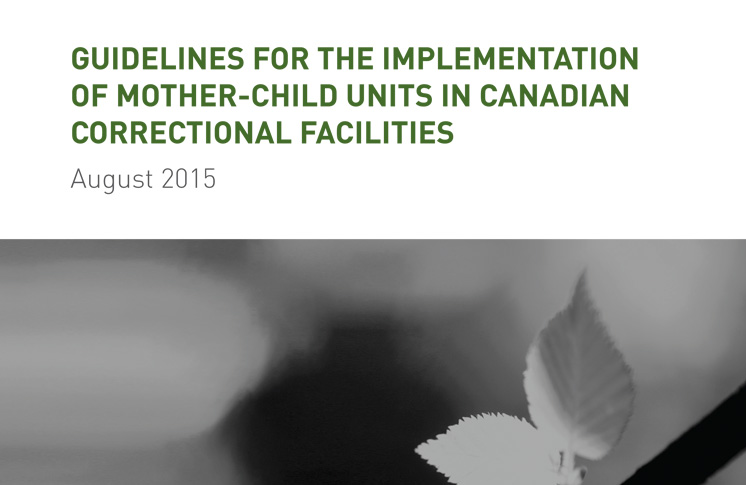
Here is what you can do to advocate for the endorsement and implementation of these guidelines in prisons. This is by no means an exhaustive list, if you have other ideas for advocacy and activism, please get in touch with us at motherbabyprisonhealth@gmail.com.
- Share the guidelines with those in your location, especially anyone working in the justice system(s), prisons, social workers, and maternal/child health (including midwives, doulas and other birth workers): http://med-fom-familymed- ccphe.sites.olt.ubc.ca/files/2015/08/MCUGuidelines_FINAL.pdf
- Utilize the recommendations outlined in the guidelines as talking points for advocacy. If you need further content and context, see the quotes of endorsing organizations below and media release statements as
examples - Organize a local launch of the guidelines in your community to increase awareness of these ongoing issues. Invite people with lived experience in the justice system(s) and prisons to speak firsthand on impacts to not only individuals, but entire families and communities. Share these advocacy points to encourage action and change. If you need any support for ideas for an event get in touch with us
- Write to your Member of Parliament (MP) asking them to endorse the guidelines and urge Corrections Canada to fully implement the recommendations, beginning with ensuring there are Mother-Child Units available in every women’s prison and that culturally safe care is provided. In addition, every effort should be made for women to receive care in the community and find alternatives to incarcerationYou can also do this on social media – by tagging them on Facebook or
Twitter and using the hashtag #MotherBabyPrisonHeatlh - Support organizations, groups and initiatives that are led by and for women with lived experience in the justice system(s) and prison. Speak back to the ongoing stigma and shame and instead find ways to support and meet people where they are at.
- Endorsement of the guidelines only goes so far. We are seeking full implementation of these guidelines to uphold the rights of incarcerated women, mothers and their children in all prison settings, and again that we find alternatives to the harms of increased incarceration. This is all of our responsibilities to make this happen!
Media Quotes
“Support programs for incarcerated mothers are essential and the Mother and Child Unit
Guidelines is an excellent resource to lead the development of these programs.
As a prison doula, I repeatedly heard stories from women about their own traumatic experiences of familial separation; growing up in the care of CPS and engaging in a number of criminalized behaviours linked to these life experiences. Women often expressed feelings of loss and devastation about such things recurring in the lives of their own children.
Engaging in breastfeeding and infant care improves physical and emotional development of baby and enhances the child-maternal bond. When separated this relationship is fractured, the developmental benefits are lost, and the maternal bond disrupted. Women in prison need programs that value and maintain the mother-child relationship. The benefits of such support should not be understated. Programs that follow the Mother and Child Unit Guidelines can function to reduce such experiences of intergenerational trauma; reducing long term CPS involvement and rates of incarceration for future generations.”
Lisa Thibodeau, Metis Nation
Indigenous Reproductive Rights Advocate Midwifery Student, Ryerson University
Former Prison Doula Program, Vanier Women’s Prison
“The National Aboriginal Council of Midwives (NACM) exists to promote excellence in reproductive health care for Inuit, First Nations, and Métis women. We advocate for the restoration of midwifery education, the provision of midwifery services, and choice of birthplace for all Aboriginal communities consistent with the U.N. Declaration on the Rights of Indigenous Peoples.
NACM recognizes that Aboriginal women are dramatically overrepresented in Canada’s prison system. In 2011-2012, 43% of admissions of women to sentenced custody were Aboriginal even though Aboriginal people make up only 4% of the Canadian adult population. ( TRC , executive summary p. 170). In addition, NACM recognizes the rates of apprehensions of infants from Aboriginal women and families in Canada is at unacceptable rates. A 2011 Statistics Canada study found that 14,225 or 3.6% of all First Nations children aged fourteen and under were in foster care, compared with 15,345 or 0.3% of non-Aboriginal children. ( TRC p. 138). By 2013 this number has increased: Almost half (48%) of all children in care under the age of 14 in Canada are Aboriginal children (Statistics Canada, 2013).
NACM fully supports the Guidelines for the Implementation of Mother- Baby Units in Canadian Correctional Facilities as we recognize the right of Indigenous families to retain shared responsibility for the upbringing of their children (UNDRIP). Aboriginal midwives view pregnancy as a sacred and transformative time in a woman’s life and support all Aboriginal women whose babies may be taken or who are taken into child protective services while enduring the additional burden of negotiating the justice system. NACM supports Aboriginal midwives working to increase culturally based equity which includes Aboriginal women’s rights to care for your children while incarcerated, and the inherent right of Aboriginal women to access individual cultural and spiritual ceremonies and traditions according to the traditions of their home community.”
National Aboriginal Council of Midwives (NACM)
“We at NYSHN know that Indigenous young women are incarcerated at much higher rates, yet also face significant amounts of violence, including state violence. This speaks to the fact that while our bodies remain over criminalized, our rights continue to be under protected. One of the first recommendations of these guidelines are that every possible effort should be made for pregnant women, mothers and babies to receive care in the community and to find sustainable alternatives to incarceration. We are extremely grateful to the mothers who led this fight and with whom this type of change would not
be possible. This work has far reaching impacts not only in BC but across Canada for mothers who are incarcerated.”
Krysta Williams
Advocacy and Outreach Coordinator, Native Youth Sexual Health Network (NYSHN)
“We call on provincial ministries of children and family development, health and justice, regional health and social service authorities, non-governmental organizations, and community groups to begin implementing the guidelines nationally in their work. The Canada FASD Research Network (CanFASD) welcomes and endorses these long- awaited recommendations, which follow a report on FASD and the Criminal Code from the Parliamentary Standing Committee on Justice and Human Rights this spring.”
Dr. Amy Salmon,
CanFASD Executive Director and Professor, University of British Columbia
“These Guidelines are predicated on the clear and compelling evidence that early mother-infant bonding supports positive future outcomes for the child, and that the child has a right to non-discrimination. The best interests of the child must be of a primary concern. It is in the best interests of children to remain with their mothers, to have the opportunity to breastfeed when possible, and be allowed to develop healthy attachments.”
Dr. Ruth Elwood Martin
Collaborating Centre for Prison Health and Education and Clinical Professor, University of British Columbia









